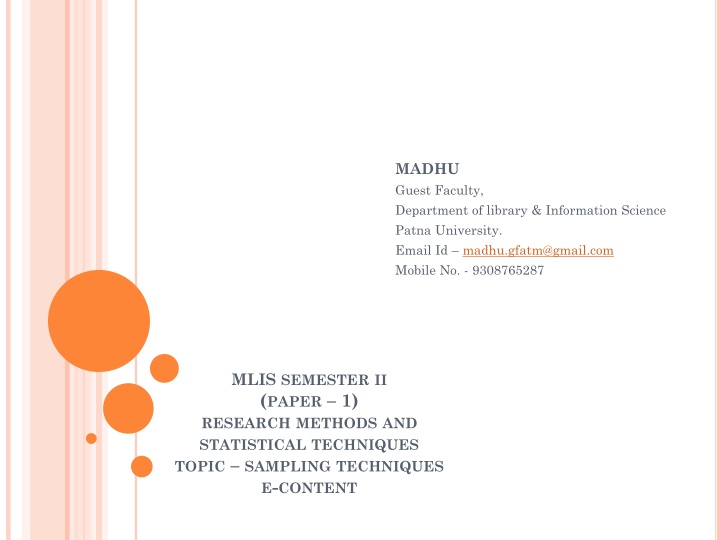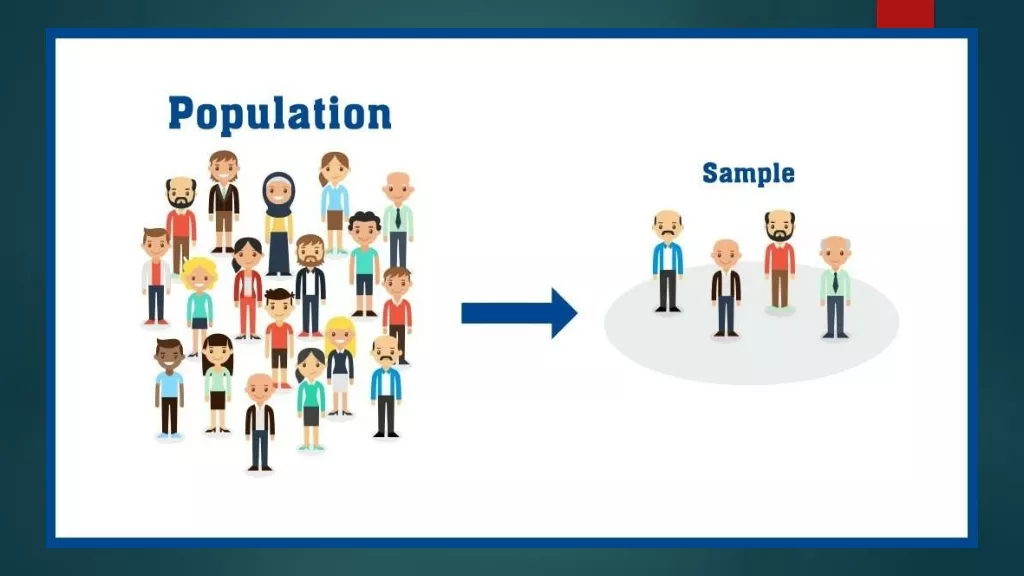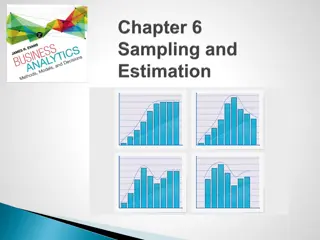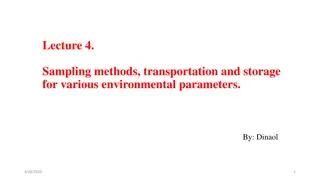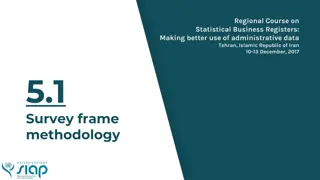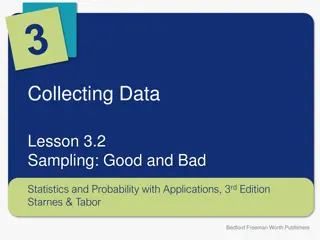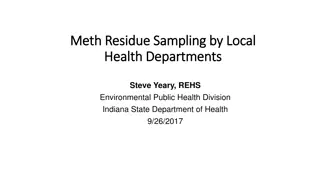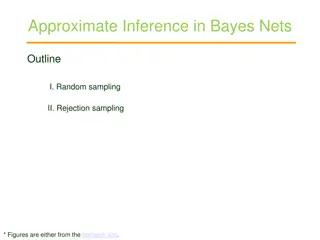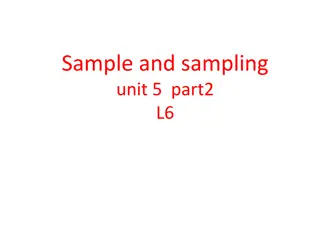Sampling Techniques in Statistical Practice
Sampling is an essential aspect of statistical practice, involving the selection of individual observations to gain insights into a specific population. It encompasses various stages, such as defining the population, determining sample size, and implementing a sampling plan. The process aids in achieving more accurate measurements, estimating sampling errors, and is crucial for statistical inference.
Download Presentation

Please find below an Image/Link to download the presentation.
The content on the website is provided AS IS for your information and personal use only. It may not be sold, licensed, or shared on other websites without obtaining consent from the author.If you encounter any issues during the download, it is possible that the publisher has removed the file from their server.
You are allowed to download the files provided on this website for personal or commercial use, subject to the condition that they are used lawfully. All files are the property of their respective owners.
The content on the website is provided AS IS for your information and personal use only. It may not be sold, licensed, or shared on other websites without obtaining consent from the author.
E N D
Presentation Transcript
MADHU Guest Faculty, Department of library & Information Science Patna University. Email Id madhu.gfatm@gmail.com Mobile No. - 9308765287 MLIS SEMESTER II (PAPER 1) RESEARCH METHODS AND STATISTICAL TECHNIQUES TOPIC SAMPLING TECHNIQUES E-CONTENT
SAMPLING TECHNIQUES Sampling is that part of statistical practice concerned with the selection of individual observations intended to yield some knowledge about a population of concern, especially for the purposes of statistical inference. Each observation measures one or more properties (weight, location, etc.) of an observable entity enumerated to distinguish objects or individuals. Survey weights often need to be applied to the data to adjust for the sample design. Results from probability theory and statistical theory are employed to guide practice.
In other words, Sampling is a process used in statistical analysis in which a predetermined number of observations are taken from a larger population.
THE SAMPLING PROCESS COMPRISES SEVERAL STAGES: Defining the population of concern, Specifying a sampling frame, a set of items or events possible to measure, Specifying a sampling method for selecting items or events from the frame, Determining the sample size, Implementing the sampling plan, Sampling and data collecting, Reviewing the sampling process.
NEED OF SAMPLING Sampling can save time and money. A sample study is usually less expensive than a census study and produces results at a relatively faster speed. Sampling may enable more accurate measurements for a sample study is generally conducted investigators . by trained and experienced Sampling remains the only way when population contains infinitely many members. Sampling remains the only choice when a test involves the destruction of the item under study. Sampling usually enables to estimate the sampling errors and thus assists in obtaining characteristic of the population. information concerning some
Sampling frame available Probability Sampling Researcher have no say in choice of sample Sampling Method No sampling frame available Non Probability Sampling Researcher have complete say in choice of sample
SAMPLING METHOD Probability Sampling Non- Probability Sampling Random Sampling Convenient Sampling Stratified Sampling Purposive Sampling Cluster Sampling Quota Sampling Multi-Stage Sampling Snow Ball Sampling Systematic Sampling
PROBABILITY SAMPLING A probability sampling scheme is one in which every unit in the population has a chance (greater than zero) of being selected in the sample, and this probability can be accurately determined. The combination of these traits makes it possible to produce unbiased estimates of population totals, by weighting sampled units according to their probability of selection.
NON - PROBABILITY SAMPLING Non probability sampling is any sampling method where some elements of the population have no chance of selection or where the probability of selection can t be accurately determined. It involves the selection of elements based on assumptions regarding the population of interest, which forms the criteria for selection. Hence, because the selection of elements is non random, non probability sampling does not allow the estimation of sampling errors. These conditions place limits on how much information a sample can provide about the population. Information about the relationship between sample and population is limited, making it difficult to extrapolate from the sample to the population.
Random sampling is the purest form of probability sampling. Each member of the population has an equal and known chance of being selected. When there are very large populations, it is often difficult or impossible to identify every member of the population, so the pool of available subjects becomes biased.
Cluster sampling , every member of population is assigned to one and only one, group. Each group is called a clusters is chosen, using a probability method (often simple random sampling). Only individuals within sampled clusters are surveyed. The difference between cluster sampling and stratified sampling. With stratified sampling, the sample includes elements from each stratum. With cluster sampling, in contrast, the sample includes elements only from sample clusters.
Multistage sampling, we select a sample by using combinations of different sampling methods. For example, in stage 1, we might use cluster sampling to choose clusters from a population. Then, in stage 2, we might use simple random sampling to select a subset of elements from each chosen cluster for the final sample.
Systematic sampling is often used instead of random sampling. It is also called an Nth name selection technique. After the required sample size has been calculated, every Nth record is selected from a list of population members. As long as the list does not contain any hidden order, this sampling method is as good as the random sampling method. Its only advantage over the random sampling simplicity. Systematic sampling is frequently used to select a specified number of records from a computer file. technique is
Stratified sampling is commonly used probability method that is superior to random sampling because it reduces sampling error. A stratum is a subset of the population that share at least one common characteristic. Examples of stratums might be males and females, or managers and non-managers. The researcher first identifies the relevant stratums and their actual representation in the population. Random sampling is then used to select a sufficient number of subjects from each stratum. Sufficient refers to a sample size large enough for us to be reasonably confident that the stratum represents the population. Stratified sampling is often used when one or more of the stratums in the population have a low incidence relative to the other stratums.
Convenience sampling is used in exploratory research where the researcher is interested in getting an inexpensive approximation of the truth. As the name implies, the sample is selected because they are convenient. This non probability method is often used during preliminary research efforts to get a gross estimate of the results, without incurring the cost or time required to select a random sample.
Purposive or Judgment sampling is a common non probability method. The researcher selects the sample based on judgment. This is usually and extension of convenience sampling. For example, a researcher may decide to draw the entire sample from one representative city, even though the population includes all cities. When using this method, the researcher must be confident that the chosen sample is truly representative of the entire population.
Quota sampling is the non probability equivalent of stratified sampling. Like researcher first identifies the stratums and their proportions as they are represented in the population. Then convenience or judgment sampling is used to select the required number of subjects from each stratum. This differs from stratified sampling, where the stratums are filled by random sampling. stratified sampling, the
Snowball sampling is a special non probability method used when the desired sample characteristic is rare. It may be extremely difficult or cost prohibitive to locate respondents in these situations. Snowball sampling relies on referrals from initial subjects to generate additional subjects.
